Significance of Determination Methods on Shear Modulus Measurements of Fujian Sand in Cyclic Triaxial Testing
Abstract
:1. Introduction
2. Laboratory Test Programs
2.1. Test Material
2.2. Test Apparatus, Specimen Preparation, and Testing Procedure
3. Determination Methods of Shear Modulus
3.1. Hysteresis Loop Method
3.2. Arithmetical Average Method
3.3. Autocorrelation Function Method
3.4. Least Square Method
4. Results
4.1. G~γ Curves
4.2. G/Gmax~γ Curves
5. Discussion
5.1. Definition of Gmax
5.2. Limitation of the Autocorrelation Function Method
6. Conclusions
- (1)
- The hysteresis loop is generally symmetrical and it becomes progressively asymmetric with increasing γ. In addition, the loading cyclic number N has a pronounced influence on the hysteresis loops with the influence becoming larger as γ increases. Both the G and G/Gmax show a tendency of decrease with increasing N.
- (2)
- The G and G/Gmax are strongly dependent on amplitudes of γ and σc. The increase in σc leads to an increase in the G and G/Gmax whereas the G decreases as γ increases. At medium shear strains (10−4~10−3), the variation in G and G/Gmax is not significant, with a percentage change generally less than 5%. However, the difference increases with decreasing σc or increasing γ, with the maximum percentage change of around 30% at σc = 50 kPa.
- (3)
- The arithmetical average method predicts almost identical results with the hysteresis loop method. Nevertheless, the larger G estimated at medium strains and the smaller G estimated at large strains for the autocorrelation function method, and least square method results in a steeper gradient of the G/Gmax curve. This thus corresponds to a smaller reference strain for these two methods.
- (4)
- Concerning the definitions of Gmax, a relatively large Gmax is calculated by 1/a, leading to an increased nonlinearity of G/Gmax. The G/Gmax determined by the autocorrelation function method is typically 30~40% lower than that of the hysteresis loop method in the strain range of 10−3~10−2 at σc = 50 kPa while the percentage change is slightly small (i.e., 20~25%) for the Gγ=10−6 case.
- (5)
- The autocorrelation function method has no capacity of capturing the dependency of G and G/Gmax on N. Both the hysteresis loop method and the least square method indicate an increased nonlinearity for high N. The comparison further demonstrates the influence of N on the uncertainty quantification of determination methods, particularly for large strains.
Author Contributions
Funding
Institutional Review Board Statement
Informed Consent Statement
Data Availability Statement
Acknowledgments
Conflicts of Interest
References
- Ovando-Shelley, E.; Ossa, A.; Romo, M.P. The sinking of Mexico City: Its effects on soil properties and seismic response. Soil. Dyn. Earthq. Eng. 2007, 27, 333–343. [Google Scholar] [CrossRef]
- Seed, H.B.; Wong, R.T.; Idriss, I.M.; Tokimatsu, K. Moduli and damping factors for dynamic analyses of cohesionless soils. J. Geotech. Geoenviron. Eng. 1986, 112, 1016–1032. [Google Scholar] [CrossRef]
- Tika, T.H.; Kallioglou, P.; Koninis, G.; Michaelidis, P.; Efthimiou, M.; Pitilakis, K. Dynamic properties of cemented soils from Cyprus. Bull. Eng. Geol. Environ. 2010, 69, 295–307. [Google Scholar] [CrossRef]
- Tunar-Özcan, R.; Ulusay, R.; Işık, N.S. Assessment of dynamic site response of the peat deposits at an industrial site (Turkey) and comparison with some seismic design codes. Bull. Eng. Geol. Environ. 2019, 78, 2215–2235. [Google Scholar] [CrossRef]
- Darendeli, M.B. Development of a New Family of Normalized Modulus Reduction and Material Damping Curves. Ph.D. Thesis, The University of Texas at Austin, Austin, TX, USA, 2001. [Google Scholar]
- EPRI. Modeling of Dynamic Soil Properties; Electric Power Research Institute: Palo Alto, CA, USA, 1993. [Google Scholar]
- Sun, J.I.; Golesorki, R.; Seed, H.B. Dynamic Moduli and Damping Ratios for Cohesive Soils; Report No. EERC 88-15; Earthquake Engineering Research Center, University of California: Berkeley, CA, USA, 1988. [Google Scholar]
- Hara, A.; Kiyota, Y. Dynamic Shear Test of Soils for Seismic Analyses. In Proceedings of the Ninth International Conference on Soil Mechanics and Foundation Engineering, Tokyo, Japan, 11–15 July 1977. [Google Scholar]
- Isenhower, W.M. Torsional Simple Shear/Resonant Column Properties of San Francisco Bay Mud. Master’s Thesis, The University of Texas at Austin, Austin, TX, USA, 1979. [Google Scholar]
- Kokusho, T. Cyclic triaxial test of dynamic soil properties for wide strain range. Soils Found. 1980, 20, 45–60. [Google Scholar] [CrossRef]
- Doroudian, M.; Vucetic, M. A direct simple shear device for measuring small-strain behavior. Geotech. Test. J. 1995, 18, 69–85. [Google Scholar]
- Menq, F.Y. Dynamic Properties of Sandy and Gravelly Soils. Ph.D. Thesis, The University of Texas at Austin, Austin, TX, USA, 2003. [Google Scholar]
- Seed, H.B.; Idriss, I.M. Soil Moduli and Damping Factors for Dynamic Analysis. Report No. EERC 70-10; Earthquake Engineering Research Center, University of California: Berkeley, CA, USA, 1970. [Google Scholar]
- Bayat, M.; Ghalandarzadeh, A. Modified models for predicting dynamic properties of granular soil under anisotropic consolidation. Int. J. Geomech. 2020, 20, 04019197. [Google Scholar] [CrossRef]
- Chen, G.X.; Zhao, D.F.; Chen, W.Y.; Juang, C.H. Excess pore-water pressure generation in cyclic undrained testing. J. Geotech. Geoenviron. Eng. 2019, 145, 04019022. [Google Scholar] [CrossRef]
- Chen, H.; Jiang, Y.L.; Niu, C.C.; Leng, G.J.; Tian, G.L. Dynamic characteristics of saturated loess under different confining pressures: A microscopic analysis. Bull. Eng. Geol. Environ. 2019, 78, 931–944. [Google Scholar] [CrossRef]
- Bocheńska, M.; Bujko, M.; Dyka, I.; Srokosz, P.; Ossowski, R. Effect of Chitosan Solution on Low-Cohesive Soil’s Shear Modulus G Determined through Resonant Column and Torsional Shearing Tests. Appl. Sci. 2022, 12, 5332. [Google Scholar] [CrossRef]
- Chen, H.; Li, H.; Fu, R.; Yuan, X.Q. Dynamic behaviour and damage characteristics of loess in Xinyang, China. Bull. Eng. Geol. Environ. 2020, 79, 2285–2297. [Google Scholar] [CrossRef]
- Cherian, A.C.; Kumar, J. Effects of vibration cycles on shear modulus and damping of sand using resonant column tests. J. Geotech. Geoenviron. Eng. 2016, 142, 06016015. [Google Scholar] [CrossRef]
- Li, J.; Cui, J.; Shan, Y.; Li, Y.; Ju, B. Dynamic Shear Modulus and Damping Ratio of Sand–Rubber Mixtures under Large Strain Range. Materials 2020, 13, 4017. [Google Scholar] [CrossRef] [PubMed]
- Liang, F.; Zhang, Z.; Wang, C.; Gu, X.; Lin, Y.; Yang, W. Experimental Study on Stiffness Degradation and Liquefaction Characteristics of Marine Sand in the East Nan-Ao Area in Guangdong Province, China. J. Mar. Sci. Eng. 2021, 9, 638. [Google Scholar] [CrossRef]
- Zhang, P.; Ding, S.; Fei, K. Research on Shear Behavior of Sand–Structure Interface Based on Monotonic and Cyclic Tests. Appl. Sci. 2021, 11, 11837. [Google Scholar] [CrossRef]
- Ciancimino, A.; Lanzo, G.; Alleanza, G.A.; Amoroso, S.; Bardotti, R.; Biondi, G. Dynamic characterization of fine-grained soils in Central Italy by laboratory testing. Bull. Earthq. Eng. 2020, 18, 5503–5531. [Google Scholar] [CrossRef]
- Ahn, S.; Ryou, J.-E.; Ahn, K.; Lee, C.; Lee, J.-D.; Jung, J. Evaluation of Dynamic Properties of Sodium-Alginate-Reinforced Soil Using A Resonant-Column Test. Materials 2021, 14, 2743. [Google Scholar] [CrossRef] [PubMed]
- Ling, X.Z.; Zhang, F.; Li, Q.L.; An, L.S.; Wang, J.H. Dynamic shear modulus and damping ratio of frozen compacted sand subjected to freeze-thaw cycle under multi-stage cyclic loading. Soil. Dyn. Earthq. Eng. 2015, 76, 111–121. [Google Scholar] [CrossRef]
- Zhou, W.; Chen, Y.; Ma, G.; Yang, L.; Chang, X. A modified dynamic shear modulus model for rockfill materials under a wide range of shear strain amplitudes. Soil. Dyn. Earthq. Eng. 2017, 92, 229–238. [Google Scholar] [CrossRef]
- Bedr, S.; Mezouar, N.; Verrucci, L.; Lanzo, G. Investigation on shear modulus and damping ratio of Algiers marls under cyclic and dynamic loading conditions. Bull. Eng. Geol. Environ. 2019, 78, 2473–2493. [Google Scholar] [CrossRef]
- Kramer, S.L. Geotechnical Earthquake Engineering; Prentice Hall: Upper Saddle River, NJ, USA, 1996. [Google Scholar]
- Kumar, S.S.; Krishna, A.M.; Dey, A. Evaluation of dynamic properties of sandy soil at high cyclic strains. Soil. Dyn. Earthq. Eng. 2017, 99, 157–167. [Google Scholar] [CrossRef]
- Liang, K.; Chen, G.X.; He, Y.; Liu, J.R. An new method for calculation of dynamic modulus and damping ratio based on theory of correlation function. Rock. Soil. Mech. 2019, 40, 1368–1376. (In Chinese) [Google Scholar]
- Shen, J.R.; Chen, S.L. Method for dynamic modulus based on least square and modified Kumar methods. Chin. J. Geotech. Eng. 2020, 42, 183–187. (In Chinese) [Google Scholar]
- Cheng, K.; Zhang, J.; Miao, Y.; Ruan, B.; Peng, T. The effect of plastic fines on the shear modulus and damping ratio of silty sands. Bull. Eng. Geol. Environ. 2019, 78, 5865–5876. [Google Scholar] [CrossRef]
- Fathi, H.; Jamshidi Chenari, R.; Vafaeian, M. Large scale direct shear experiments to study monotonic and cyclic behavior of sand treated by polyethylene terephthalate strips. Int. J. Civ. Eng. 2021, 19, 533–548. [Google Scholar] [CrossRef]
- Liu, H.X.; Gao, K.F.; Zhu, X. Experimental study on dynamic fatigue properties of dolomite samples under triaxial multilevel cyclic loading. Bull. Eng. Geol. Environ. 2021, 80, 551–565. [Google Scholar] [CrossRef]
- Liu, X.; Li, S.; Sun, L.Q. The study of dynamic properties of carbonate sand through a laboratory database. Bull. Eng. Geol. Environ. 2021, 79, 3843–3855. [Google Scholar] [CrossRef]
- GB/T 50123-2019; Standard for Soil Test Method. China Planning Express: Beijing, China, 2019.
- Hardin, B.O.; Drnevich, V.P. Shear modulus and damping in soils: Design equations and curves. J. Soil. Mech. Found. Div. 1972, 98, 667–692. [Google Scholar] [CrossRef]
- Ishibashi, I.; Zhang, X. Unified dynamic shear moduli and damping ratios of sand and clay. Soils Found. 1993, 33, 182–191. [Google Scholar] [CrossRef]
- Huang, X.; Cai, X.G.; Bo, J.S.; Li, S.H.; Qi, W.H. Experimental study of the influence of gradation on the dynamic properties of centerline tailings sand. Soil Dyn. Earthq. Eng. 2021, 151, 106993. [Google Scholar] [CrossRef]
- Senetakis, K.; Payan, M. Small strain damping ratio of sands and silty sands subjected to flexural and torsional resonant column excitation. Soil. Dyn. Earth. Eng. 2018, 114, 448–459. [Google Scholar] [CrossRef]
- Wichtmann, T.; Triantafyllidis, T. Influence of the grain-size distribution curve of quartz sand on the small strain shear modulus Gmax. J. Geotech. Geoenviron. Eng. 2009, 135, 1404–1418. [Google Scholar] [CrossRef]

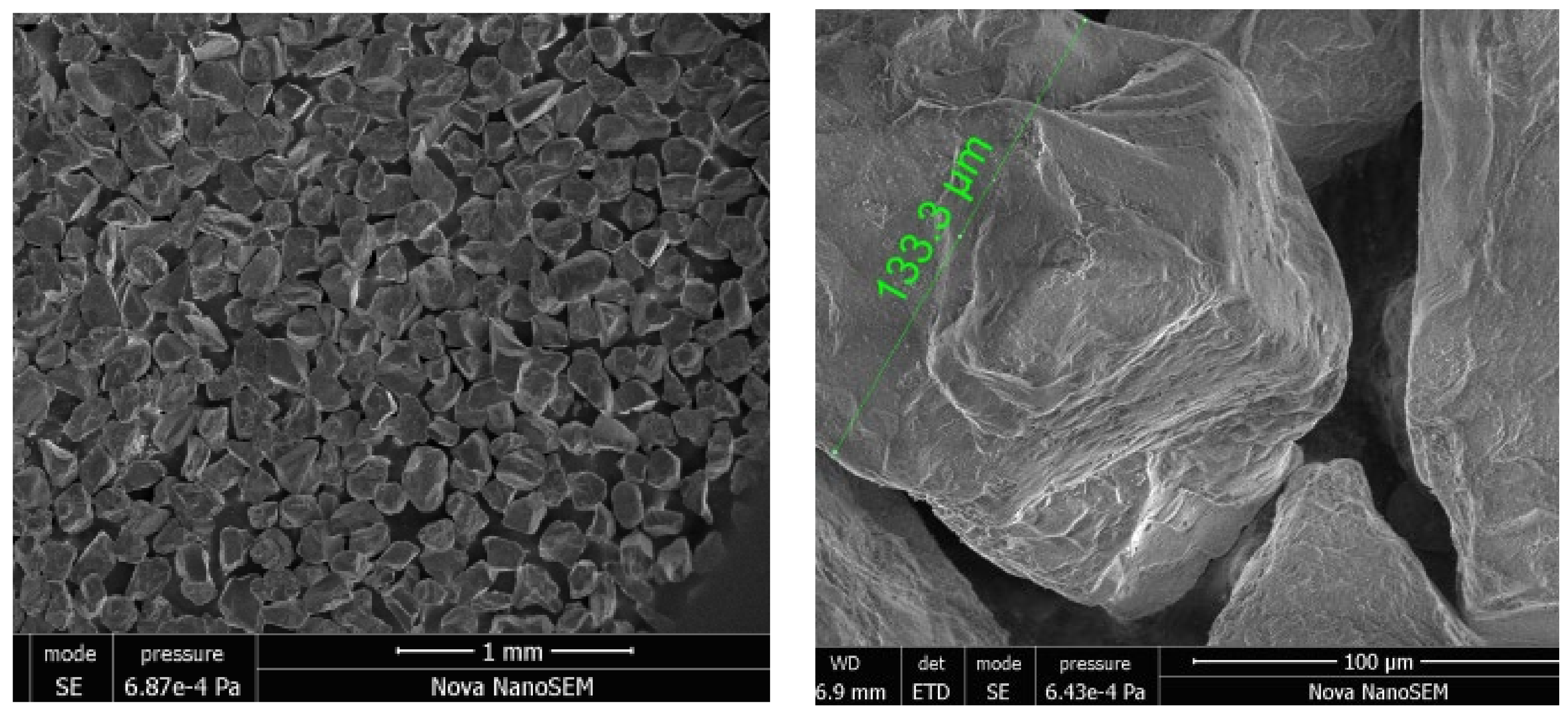
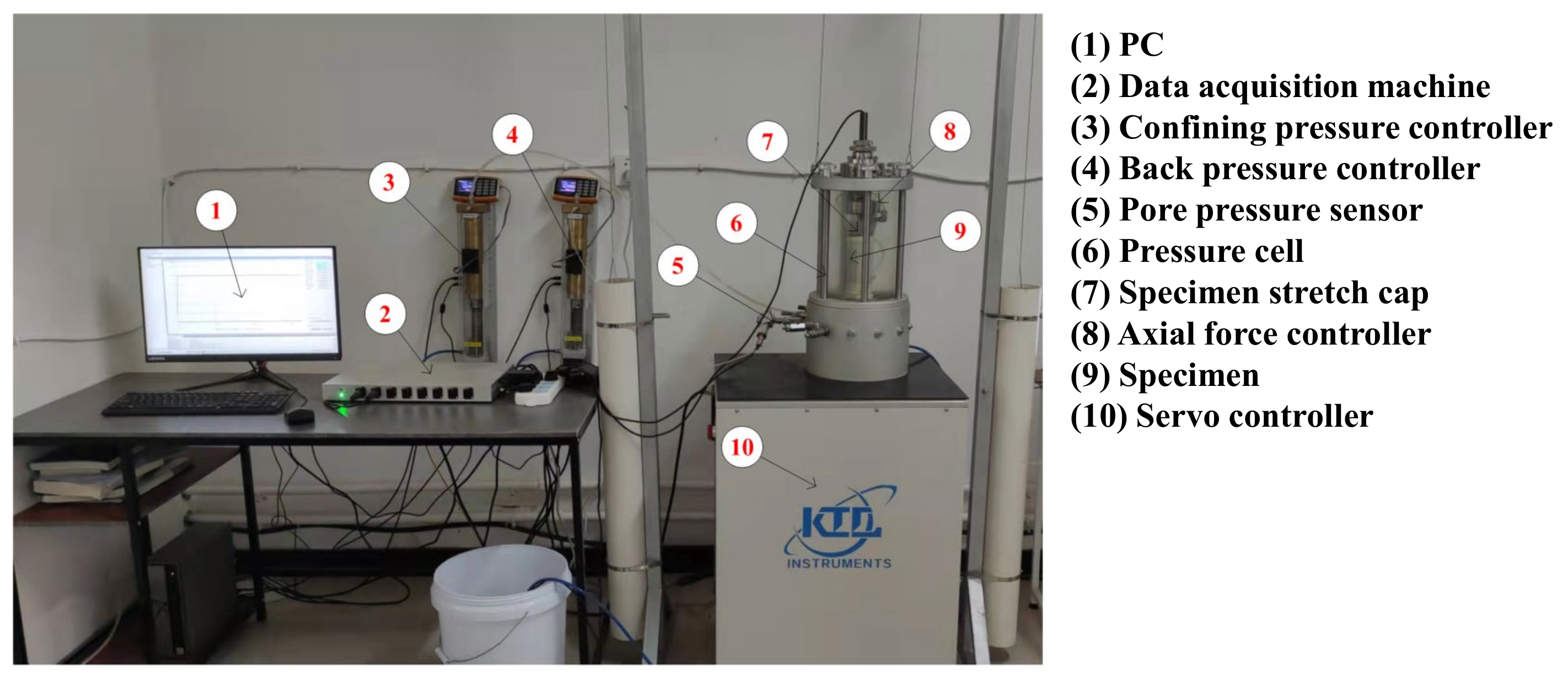

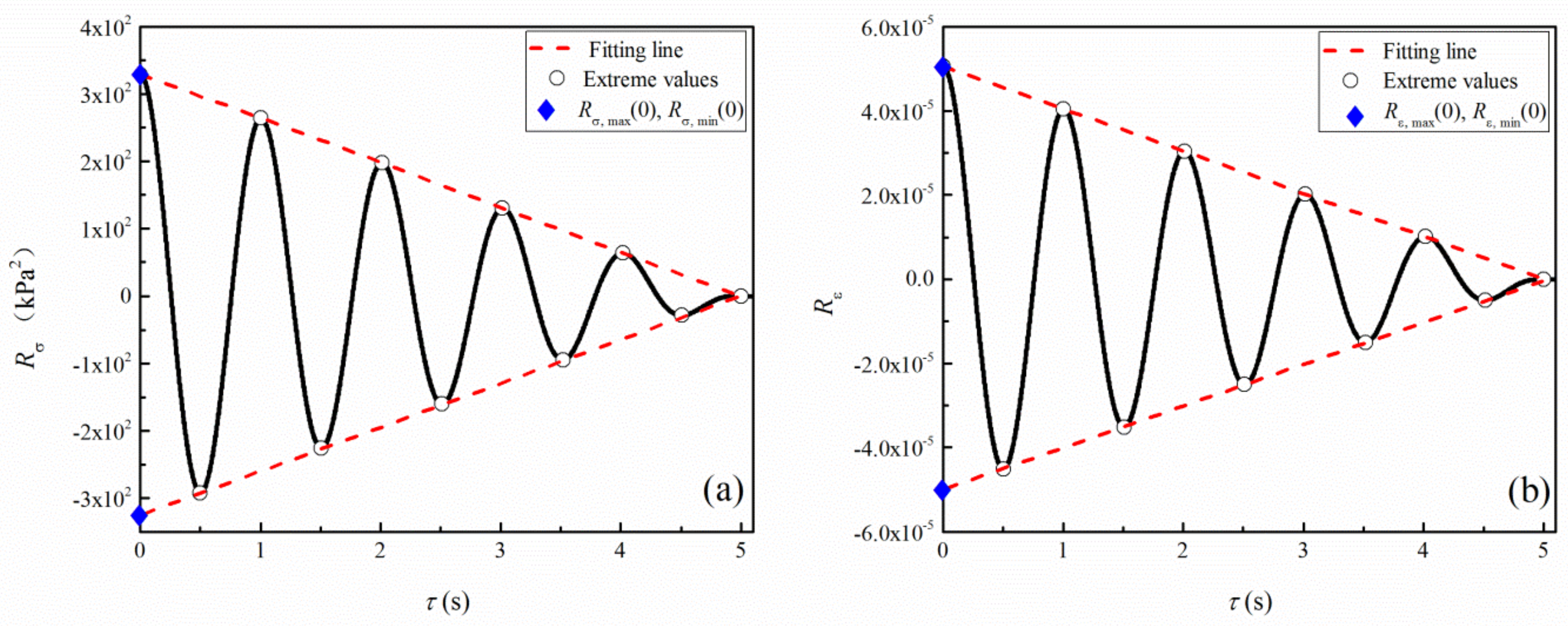
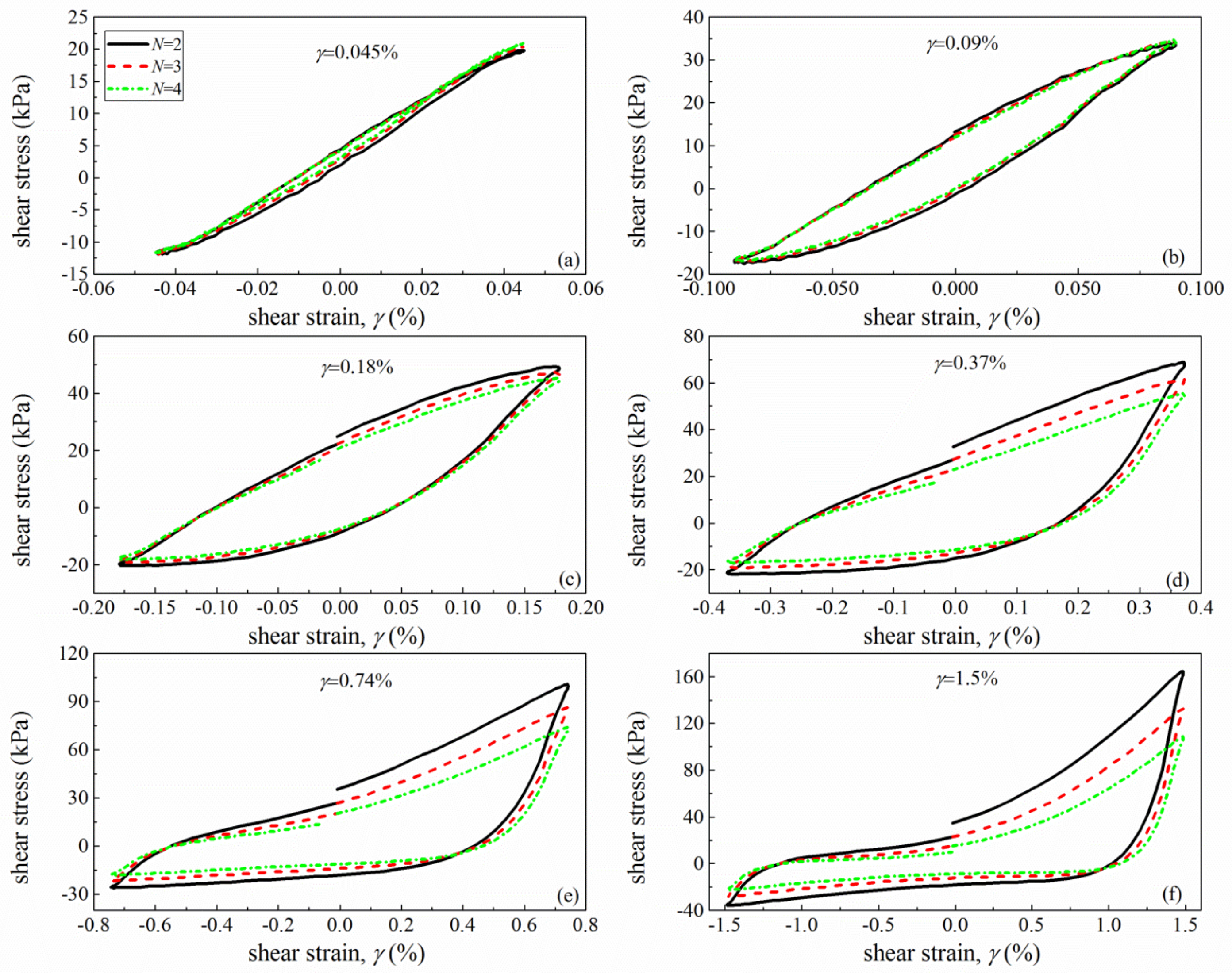
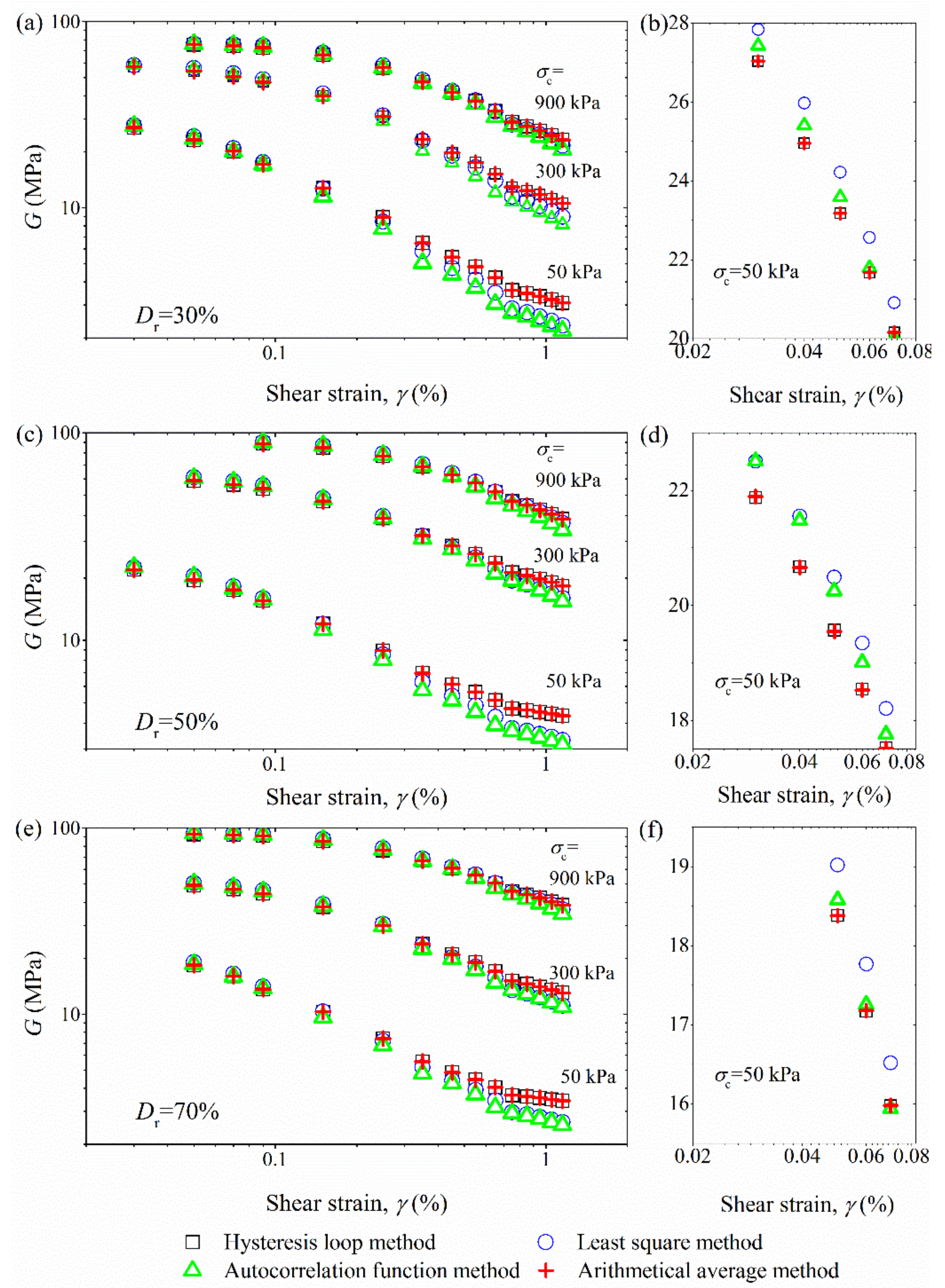
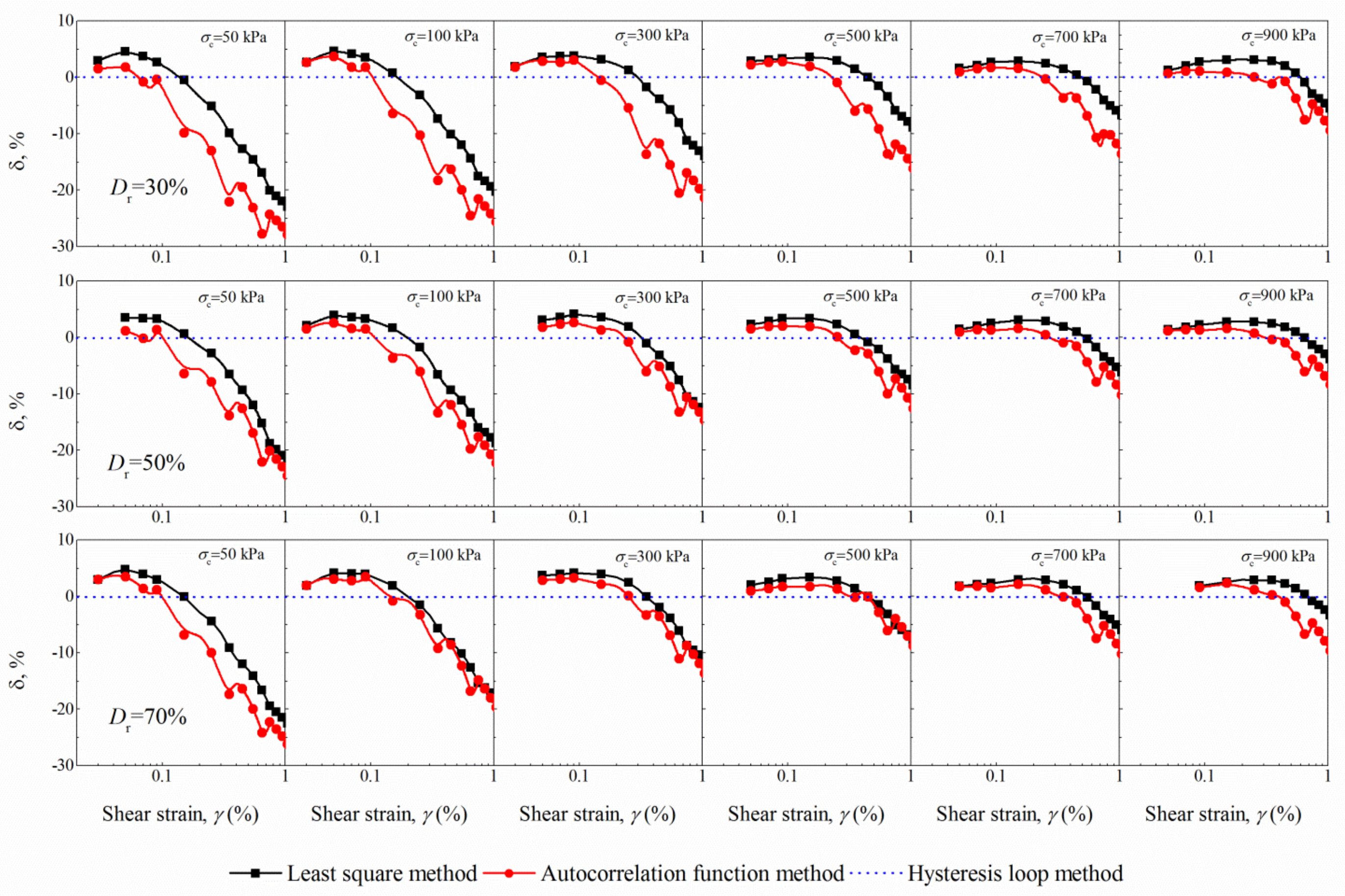

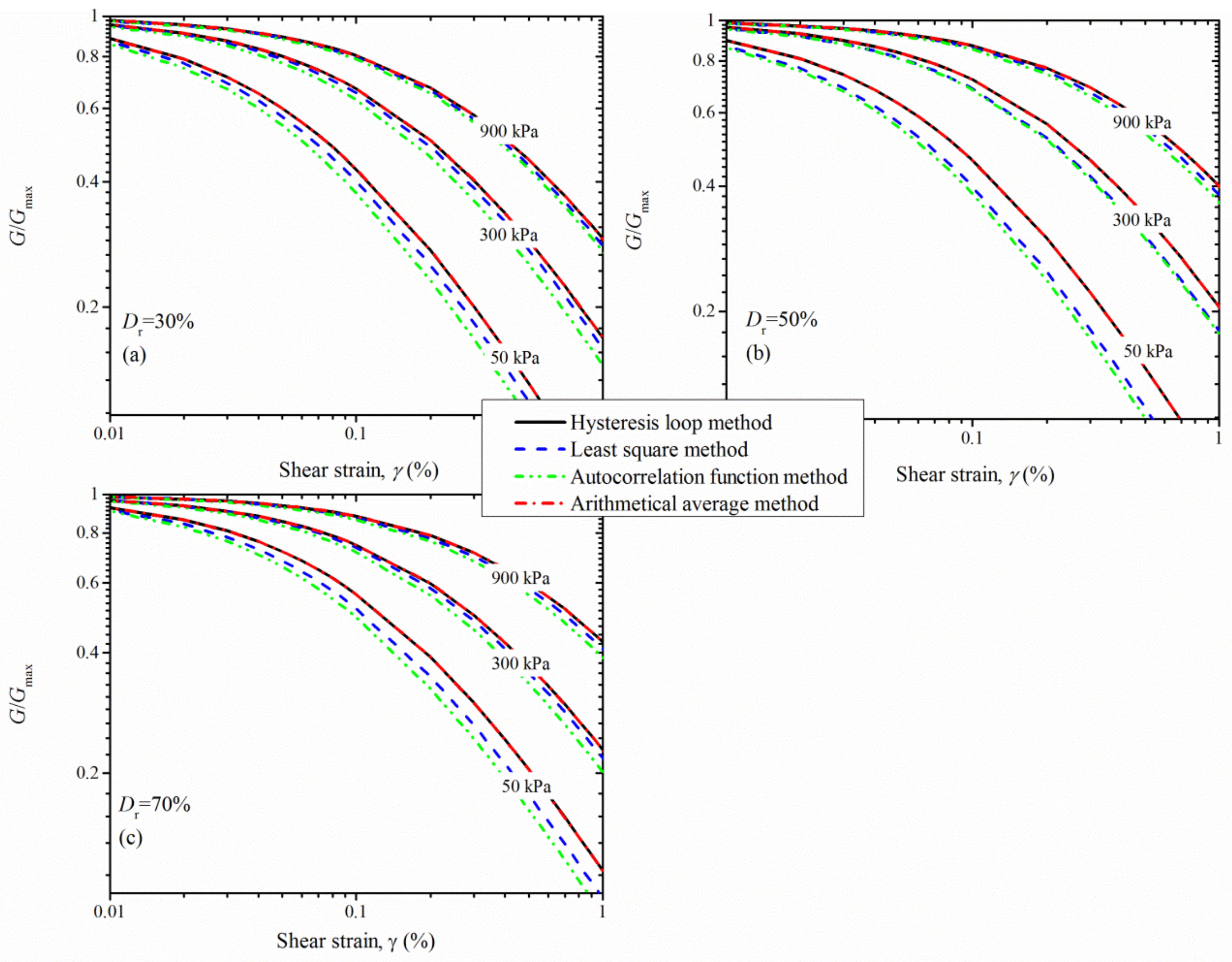

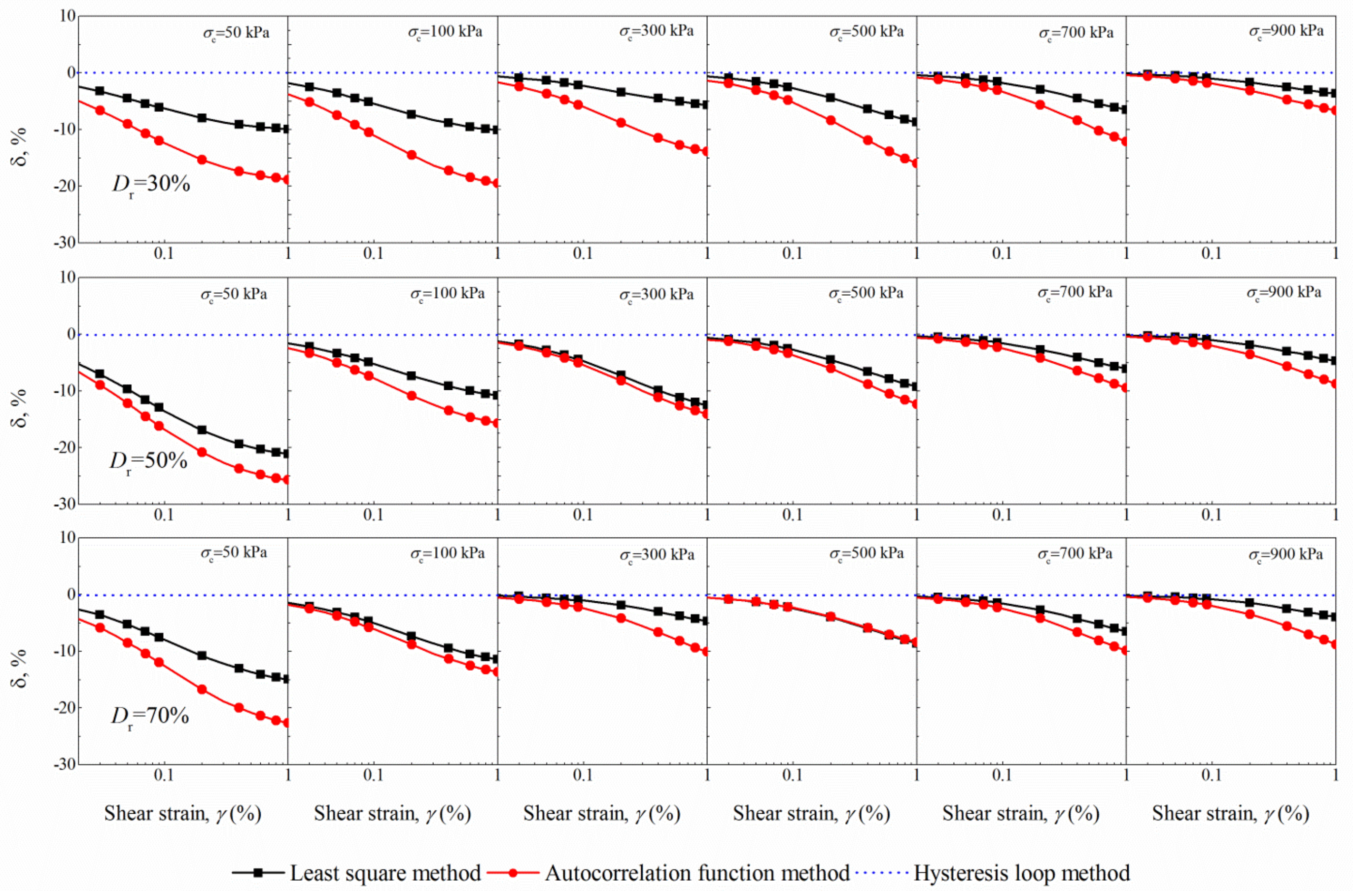
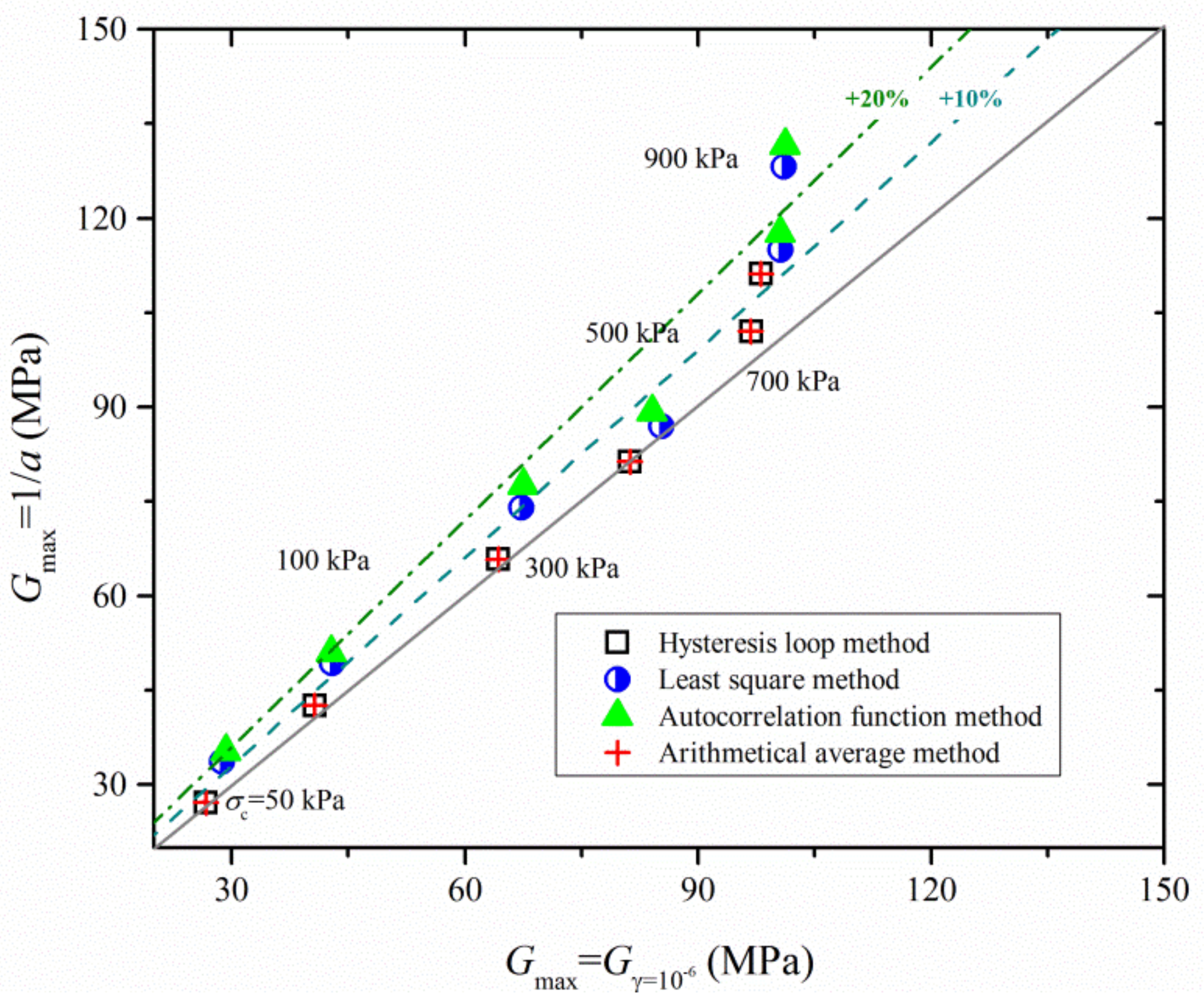



| Soil | Gs | emin | emax | d50 (mm) | d10 (mm) | d60/d10 |
|---|---|---|---|---|---|---|
| Fujian sand | 2.64 | 0.69 | 1.01 | 0.175 | 0.115 | 1.65 |
Publisher’s Note: MDPI stays neutral with regard to jurisdictional claims in published maps and institutional affiliations. |
© 2022 by the authors. Licensee MDPI, Basel, Switzerland. This article is an open access article distributed under the terms and conditions of the Creative Commons Attribution (CC BY) license (https://creativecommons.org/licenses/by/4.0/).
Share and Cite
Song, D.; Liu, H.; Sun, Q. Significance of Determination Methods on Shear Modulus Measurements of Fujian Sand in Cyclic Triaxial Testing. Appl. Sci. 2022, 12, 8690. https://doi.org/10.3390/app12178690
Song D, Liu H, Sun Q. Significance of Determination Methods on Shear Modulus Measurements of Fujian Sand in Cyclic Triaxial Testing. Applied Sciences. 2022; 12(17):8690. https://doi.org/10.3390/app12178690
Chicago/Turabian StyleSong, Dongsong, Hongshuai Liu, and Qiangqiang Sun. 2022. "Significance of Determination Methods on Shear Modulus Measurements of Fujian Sand in Cyclic Triaxial Testing" Applied Sciences 12, no. 17: 8690. https://doi.org/10.3390/app12178690




